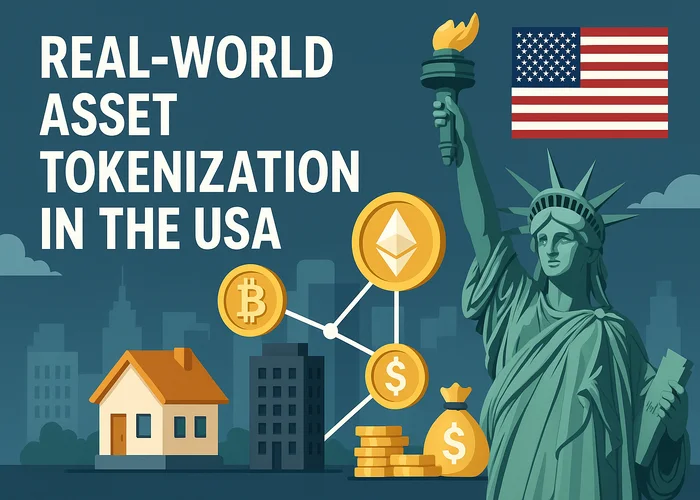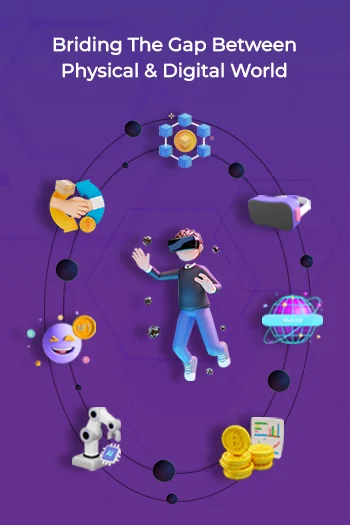Blockchain technology and digital assets are changing the financial world in a big way. The technique of turning traditional assets into digital tokens on a blockchain, called asset tokenization, is at the vanguard of this change. There is little doubt that Real-World Asset Tokenization in the USA has a lot of potential in the United States, a country famed for its strong financial markets and pioneering spirit. However, it can be hard to keep up with the changing rules and regulations that come with this new technology. This in-depth blog goes into great detail on the complicated world of US asset tokenization rules, making it easy for both new and experienced investors to understand.
Asset Tokenization: Unlocking a World of Possibilities
The main idea behind Real-World Asset Tokenization in the USA is to make digital tokens that show who owns a real-world asset. These tokens are stored on a blockchain, which is a type of distributed ledger technology that makes things unchangeable, clear, and more secure. The asset might be anything from U.S. real estate tokenization and RWA and precious metals to intellectual property and even owning a small part of a company. Real-World Asset Tokenization in the USA opens up a lot of benefits by using blockchain:
More liquidity: Digital tokens may be broken up into smaller, more tradable pieces, making it easier for more investors to get involved. Think about how a piece of real estate could be broken up into tokens that people could trade. This would let people invest in a little part of the property without having to put down a lot of money up front.
Improved Efficiency: Processes for issuing, trading, and settling assets are more efficient, which lowers costs and administrative hassles. The days of long settlement timeframes and plenty of paperwork are over. Blockchain technology makes many tasks automatic, which makes the system more efficient and less expensive.
Better Transparency: Blockchain technology keeps a permanent record of ownership and transaction history, which makes things more open and lowers the chance of fraud. The blockchain keeps a permanent record of every transaction that uses a token, giving everyone involved a clear audit trail.
Fractional Ownership: Real-World Asset Tokenization in the USA makes it possible for people to own parts of assets that were once impossible to divide, making investment opportunities available to more people. This lets people own high-value assets that many investors couldn’t afford before.
Global Reach: Digital tokens can be exchanged throughout the world at any time of day or night, breaking down geographic barriers and making the market more linked. People from all over the world can buy and sell tokenized assets USA, which makes the market more liquid and efficient.
Benefits of Real-World Asset Tokenization in the USA
Tokenized assets USA blockchain offer numerous benefits, including:
Liquidity: By enabling globally accessible liquidity conditions on a unified substrate—the blockchain ecosystem with cross-chain activity supported by Chainlink CCIP tokenized Real-World assets blockchain enable increased market liquidity for traditionally illiquid assets.
Transparency: Since the tokenized real estate USA assets are represented onchain, transparency and auditable asset management are ensured, which decreases overall systemic risks, as the amount of leverage and risk in the entire system can be more accurately determined.
Accessibility: Real-World Asset Tokenization in the USA can broaden the potential user base of certain asset types by enabling easier access through blockchain-based applications and allowing a broader set of users to utilize assets that would otherwise be unavailable to them through fractional ownership.
How Asset Tokenization Works
Role of Blockchain
Smart Contracts Overview
Smart contracts are agreements that run themselves and are stored on the blockchain. They make things like issuing tokens, transferring ownership, and paying dividends easier. A smart contract can, for instance, enforce restrictions for fractional ownership or automate royalty payments for art that has been tokenized.
The main idea behind Real-World Asset Tokenization in the USA is to turn real-world assets into blockchain tokens that are safe and can be traded. These are the steps that the procedure usually follows:
- Asset Identification: Choose the real-world asset, such property, stocks, or commodities.
- Legal and Compliance Setup: Make sure you follow the rules and protect your ownership rights.
- Token Creation: Make tokens on the blockchain that represent the asset in a digital way.
- Distribution and Trading: Give investors tokens through safe channels.
- Lifecycle Management: Handle payments, transfers, and compliance on-chain.
Navigating RWA Investment with Token Metrics
Due to the rapid tokenization of real-world assets in the U.S. investors encounter hundreds of initiatives and platforms. Due of this complexity, sophisticated technologies are needed to identify opportunities and manage risk. Token Metrics, a major crypto trading and analytics tool, is vital. It analyzes tokenized bonds USA, tracks RWA development company USA protocols, and provides data-driven insights. Investors may confidently analyze project fundamentals, regulatory needs, and tokenomics.
The platform’s AI-driven evaluations and indexes let users compare tokenized real estate USA, private credit, and Treasury Bonds Tokenization. Investors receive U.S. real-world asset tokenization market data and alerts on new institutional partnerships and securities law changes affecting tokenized assets.
Token Metrics provides a common platform to optimize allocation, evaluate correlations, and navigate the changing financial landscape for diverse portfolios of native crypto and Real-World Asset Tokenization in the USA.
Why Tokenizing U.S. RWAs Is a Strategic Business Opportunity?
Real-World Asset Tokenization in the USA goes beyond blockchain asset placement. It involves rethinking money, ownership, and investment for firms. U.S. market for tokenized real-world assets cannot ignore the computed value of U.S. RWA tokenization platforms for institutions when trillions are locked in conventional systems.
Unlocking Liquidity and Fractional Ownership
In conventional finance, idle value is frustrating. Real estate, Private Equity Tokenization, and other high-value assets trap cash for years. Companies have less flexibility because of this. This changes with Real-World Asset Tokenization in the USA. Companies convert these assets into fractional tokens to allow investors to buy smaller amounts of assets previously reserved for deep-pocketed participants.
This is about liberating capital from extended lock-ups, not just lowering the entry barrier. Flexibility helps investors exit and enter faster. Higher capital turnover benefits businesses. According to World Economic Forum findings and RedStone perspectives, this liquidity can make markets more resilient and accessible.
Fractional ownership can break a $10 million property into hundreds of tradeable components. That makes real estate a dynamic, not illiquid, investment class. Ripple effect? Later, investor activity, efficiency, and participation rose.
Democratizing Institutional Asset Class Access
Institutional gates have sealed premier asset classes like bond tokenization, real estate, and private credit funds for decades. This is opened via tReal-World Asset Tokenization in the USA. Businesses can reach more investors by issuing digital tokens without compromising compliance.
Retail and smaller investors can now access hedge funds and major institutions’ high-ticket products. Platforms experimenting with tokenized securities show that tokens can democratize investment and distribute wealth fairly.
Clearly, real-world asset tokenization regulations in the U.S. changes who trades assets and whose assets are traded. That allows enterprises to access previously unattainable financing and strengthen and diversify investor groups.
Operational and Cost Efficiencies Through Blockchain
Cost and Operational Efficiency Real-World Asset Tokenization on Blockchain offers practical benefits beyond liquidity and availability. Real-World Asset Tokenization makes processes leaner and cheaper. Endless reconciliations, intermediaries, and manual processes impede transactions and raise expenses in traditional finance. Much of that friction is gone. Blockchain does this.
Smart contracts monitor compliance, pay dividends, and distribute yield. Thus, firms reduce their use of keepers, passing salespeople, and brokers. Previously days-long settlements now take minutes, boosting cash flow and decreasing counterparty risk.
Cost savings are only part of the tale. Since transactions are transparent and verifiable in real time, faster settlements and automatic reporting build investor trust. That gives asset managers and fintechs a competitive edge and a clear path to scale if overheads are low.
Conclusion
Tokenization of real-world assets in the U.S is one of the most exciting uses of blockchain technology. DeFi brought a lot of traditional assets to the blockchain Real-World Asset Tokenization in the USA and crypto world. With RWA investment USA, you can see real-world assets becoming well-known crypto currencies. In the blockchain and crypto world, real-world assets will make a new market that can attract more investors.
Putting real-world things like real estate, music licenses, Digital asset tokenization USA
content rights, or artwork into tokens might bring about a lot of benefits. With tokenized real-world assets, you may enjoy the benefits of fractional ownership, more liquidity, and more openness in asset management. To understand how real-world assets are tokenized in the U.S. will be for the future of finance, learn more about asset tokenization in crypto.



